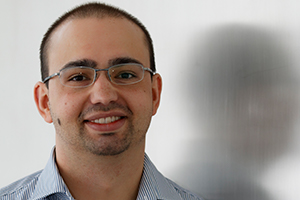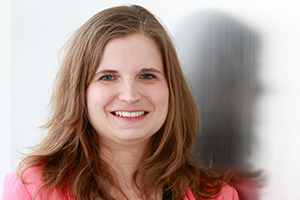Dr. Blazej Grabowski und Dr. Katja Hübel
In his project TIME-BRIDGE Blazej Grabowski will describe the thus far missing time interval between nanoseconds and hours using a novel method of atomistic simulation.
In his project TIME-BRIDGE Blazej Grabowski will describe the thus far missing time interval between nanoseconds and hours using a novel method of atomistic simulation.
Modern material science is based on atomistic computer simulations. For these, huge timescales must be overcome – from femtoseconds to hours. In his project TIME-BRIDGE Blazej Grabowski will describe the thus far missing time interval between nanoseconds and hours using a novel method of atomistic simulation.

Max-Planck-Institut für Eisenforschung GmbH
Modern material science is based on atomistic computer simulations. For these, huge timescales must be overcome – from femtoseconds to hours. This roughly correlates with a time span between one second and several billion years. This cannot be resolved by today’s simulation methods.
The main objective of the project TIME-BRIDGE is to tackle this fundamental time problem with a novel, multi-disciplinary approach. This approach uses a concept which has been applied successfully in a neighbouring discipline, the electron theory, for many years: the so-called pseudopotential method. Within TIME-BRIDGE my goal is to develop and test equivalent methods for atomistic simulations to bridge the interval between theoretically describable nanoseconds and experimentally relevant seconds and, thus, break new ground for the development of novel materials.
The project is multi-disciplinary, and the close collaboration of theoretical and experimental researchers is a central element of TIME-BRIDGE. In particular, the integration of novel experimental measurements must be highlighted, allowing us to evaluate the developed simulation methods. Another unique feature is the application of the pseudopotential method for the simulation of atoms.
The ERC Starting Grant allows me to establish an independent career with my own research group. In addition, ERC grants have such a high reputation that they provide an excellent starting point for applications at European top institutions.
Time and effort to plan and write a good proposal in addition to the everyday work in research were very high. The project needs to be planned in detail for five years including the budget. The proposal was revised by Katja Hübel and many peers a number of times.
From our EU liaison officer.
To get a lot of advice! If available, as it was in our case, ask your EU liaison office, someone proficient in research coordination, or the NCP ERC. Further, workshops offered e. g. by the NCP ERC are most helpful. You should also try to get in touch with former ERC grantees to get successful proposals as templates. A professional interview training (as offered in my case by the NCP ERC) is highly recommendable.

Max-Planck-Institut für Eisenforschung GmbH
In a personal conversation I have a look at the applicant’s scientific CV. Is the researcher suited for the competitive application? Where are the weak points? Does an application make sense already or would it be better to promote the career a bit further? Then I ask the applicant to explain the project to me. How innovative is the planned approach? What would be the scientific breakthrough? How risky is the project? What are the challenging parts for which an alternative strategy must be available? Once the rough outline is clear I help the applicant plan the budget and fill out the forms on the Funding & Tenders Portal.
When a first draft of the proposal is finished I give feedback considering the evaluation criteria. Depending on the time available there are several rounds of feedback with me and peers.
As a first step you should seek advice either with your local research liaison office or with the NCP ERC. The amount of time required to write a proposal is often underestimated. Planning of the project and inspection of the proposal documents and evaluation criteria should begin in good time. It is absolutely recommendable to attend one of the many workshops on ERC application. There you will receive lots of useful tips and often first-hand reports by successful applicants. One should also schedule some time for discussions with peers. It is further imperative to get the proper figures for budget planning from the host institution, as well as the correct data of all the contacts to be included in the administrative forms. Also, it is very important to have the “Commitment of the host institution” signed early.
Since excellence of project and researcher is the most important criterion, one should take care of illustrating this properly in the proposal. Apart from that, follow the detailed instructions in the "Information for Applicants" and in the end check whether all evaluation criteria have been met. Often the applicants need help with the Funding & Tenders Portal. Therefore, you should familiarise yourself with this tool at an early stage. For budget planning the research funding department of the host institution should be included regarding correct figures, especially personnel costs. It is advisable to attend one of the NCP ERC seminars for multipliers. Successful proposals are a big help, too.
Pitfalls of proposal submission are a too narrow time margin, completion of the A-forms and budget planning. If an EU liaison officer is available at your institution he/she can help you with the A-forms and the budget. At project implementation a lot of time is often lost until the first team members are recruited. Since extension of the project without additional costs is becoming more and more difficult, this is a critical factor.
Before I had acquired the expertise to give advice on proposal writing myself, I attended the NCP ERC seminars, made use of advice received over the phone and benefited from the possibility of confidential proposal checks. Currently I am organising a workshop together with a colleague and the NCP ERC on proposal submission in ERC Starting and Consolidator Grant Calls for Max Planck scientists in North Rhine-Westphalia. These workshops make the application easier not only for researchers, but also for me since the draft version of the proposal after such a workshop is usually very good.
At the moment we have an ERC Starting Grantee and an ERC Co-Investigator grant (which no longer exists in this fashion) at our institute. We regularly advise our researchers of the possibility to apply for an ERC grant, and support by the directors and fellow scientists during the application phase is high. We give intensive feedback on the proposal which is usually discussed a lot. In case of an invitation to an interview we work on the presentation just as intensively. The ERC grant means a special distinction to the researcher as well as to us as research institution.